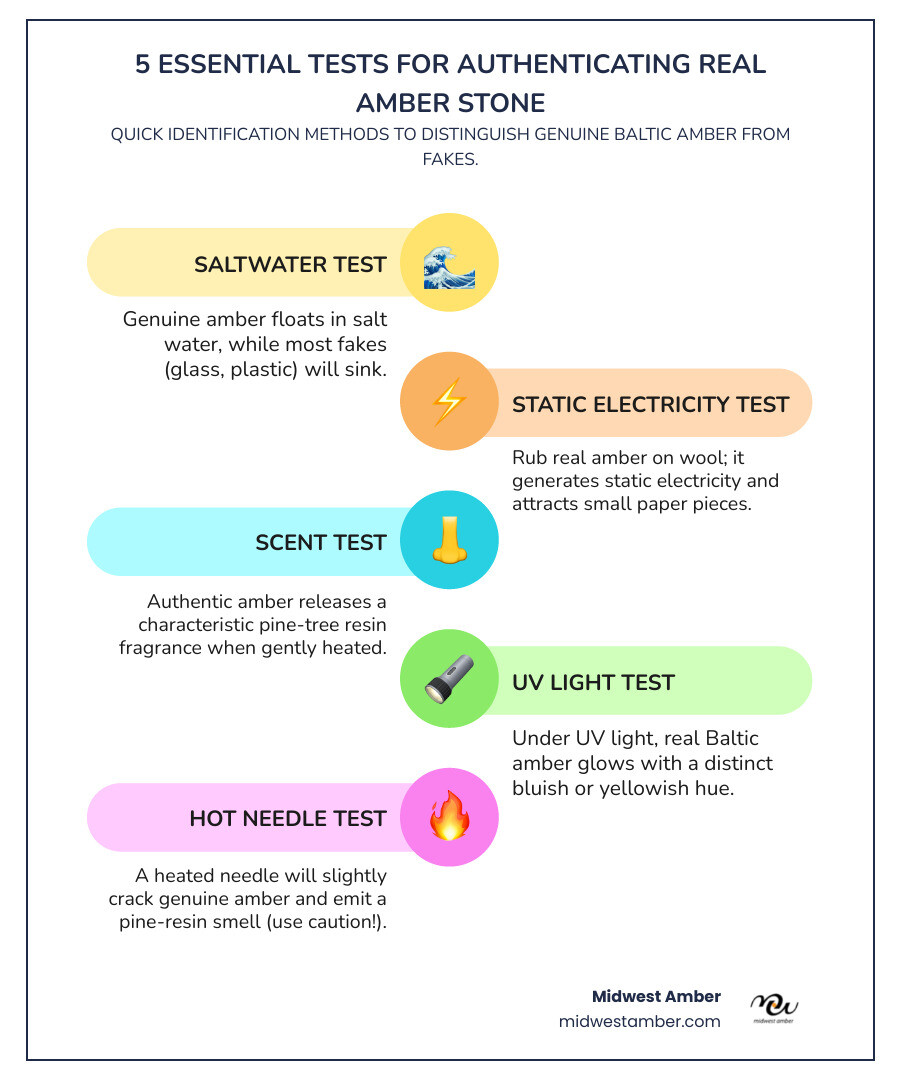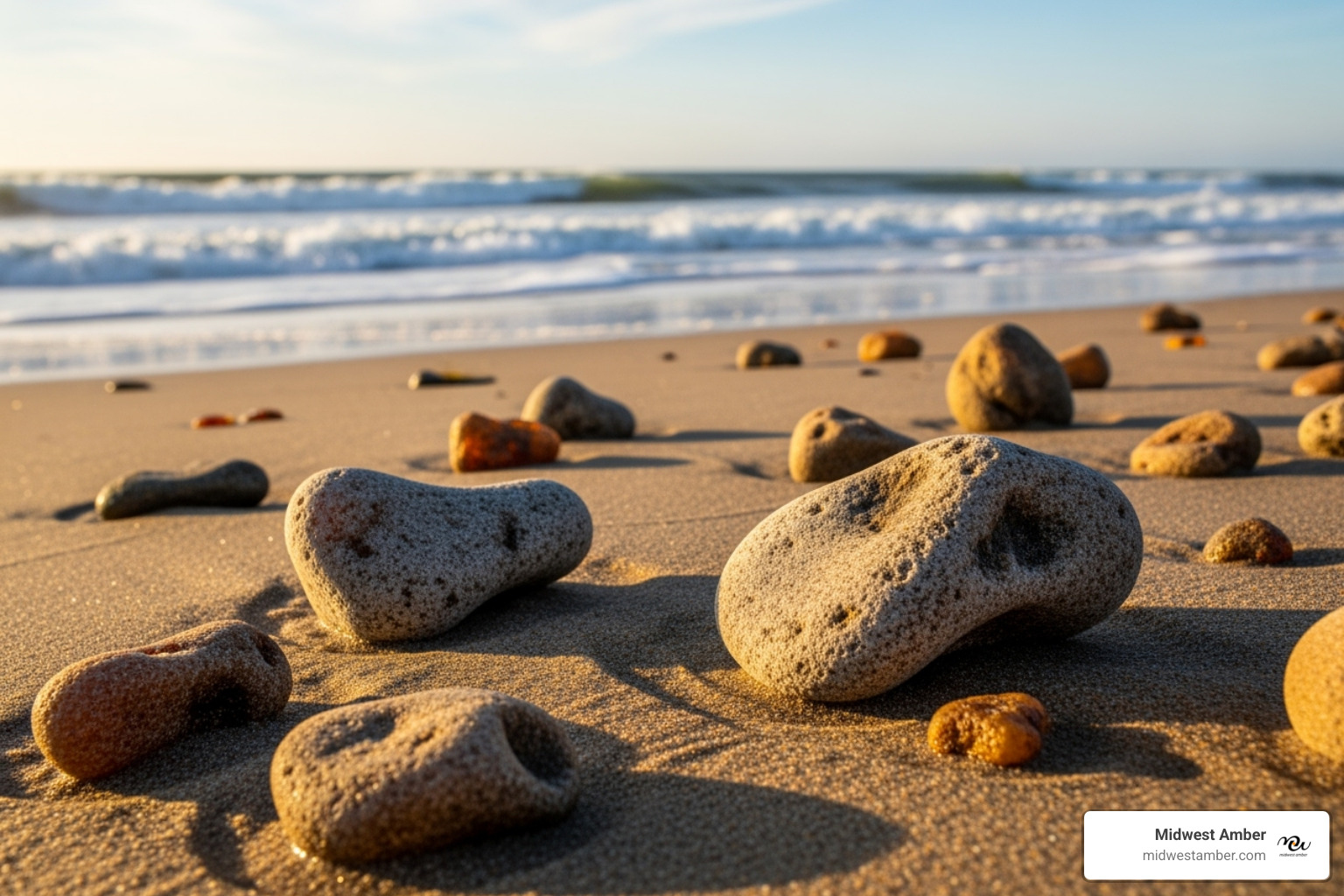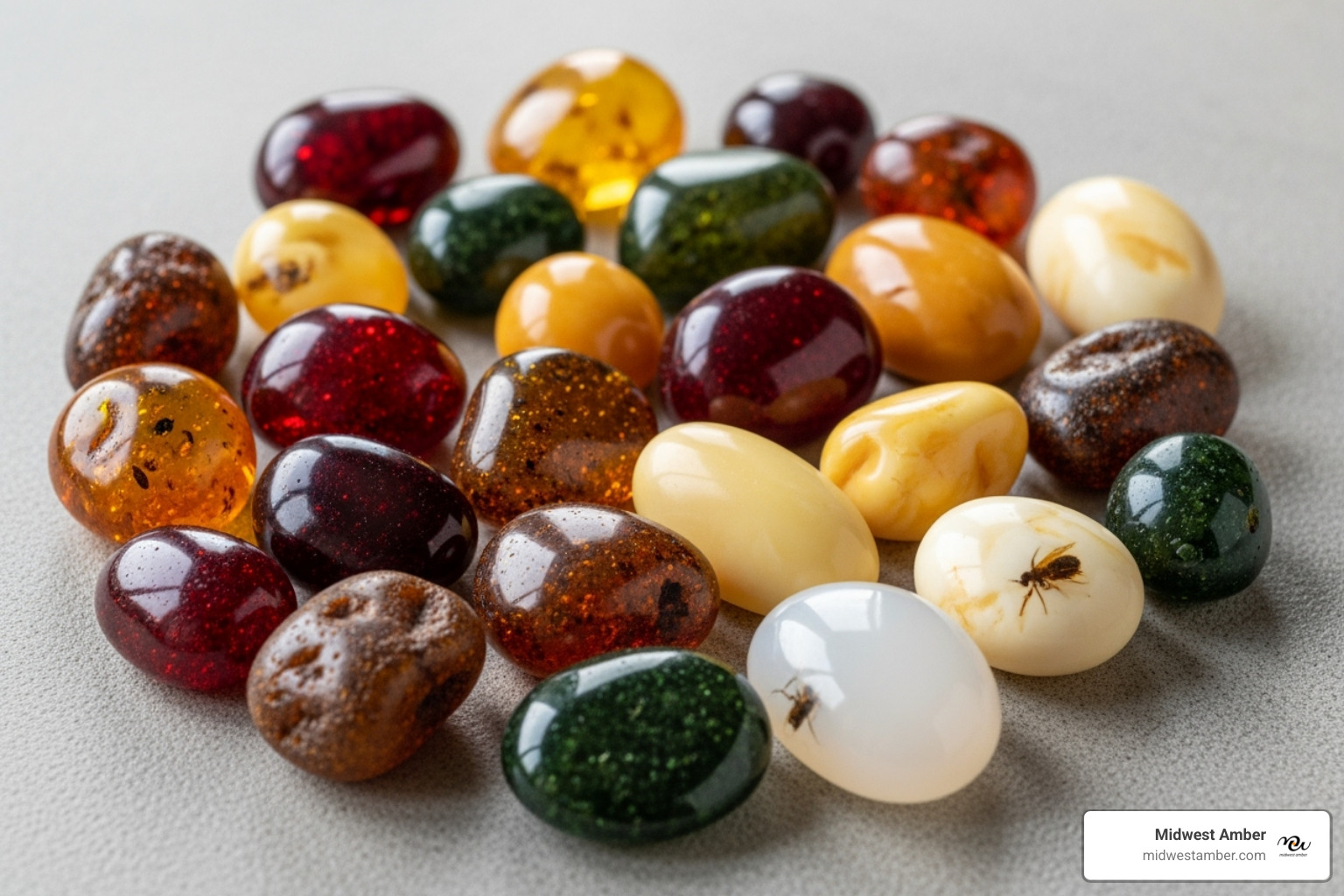Why Identifying Genuine Amber Matters in Today's Market
Real amber stone identification is crucial as the market is flooded with imitations. Distinguishing authentic Baltic amber from fakes made of plastic, glass, or young resin called copal requires specific knowledge and testing methods.
Quick identification methods for real amber stone:
- Saltwater test: Genuine amber floats in salt water.
- Static electricity test: Real amber becomes statically charged when rubbed on wool.
- Scent test: Authentic amber releases a pine-resin scent when heated.
- UV light test: Real amber glows bluish or yellowish under UV light.
- Hot needle test: A hot needle will release a pine scent and may crack the amber.
Beyond monetary value, genuine amber offers a connection to ancient history, formed over 45 million years ago from prehistoric pine trees. Fakes simply can't offer the same connection to our planet's distant past.
Each genuine piece tells a story, sometimes preserving prehistoric life within its golden depths. But with certificates of authenticity being unregulated, practical verification skills are essential to ensure you're buying the real thing.
I'm Gabriel Ciupek, President and owner of Midwest Amber, Inc. My experience in amber identification and quality verification ensures that every piece of Real amber stone we offer meets and exceeds expectations.

The Journey of Baltic Amber: From Ancient Resin to Prized Gem

From 40 to 60 million years ago, ancient Pinus succinifera pine forests covered what is now the Baltic Sea region of Poland and Lithuania. These trees produced the resin that would become the precious real amber stone we treasure today.
When these prehistoric trees were injured, they oozed sticky resin to heal their wounds. As climate changes caused the forests to fall, rivers carried chunks of this hardened resin toward coastal areas, where it was buried under layers of sediment.
Over millions of years, immense heat and pressure caused a process called polymerization, which slowly transformed the soft resin into the durable, beautiful material that washes up on Baltic beaches.
What makes Baltic amber truly special is its high concentration of succinic acid. This fossilized resin is composed of about 79% carbon, 10.5% hydrogen, and 10.5% oxygen, along with over 40 other compounds and mineral salts.
The word "amber" comes from the German "Bernstein," meaning "the burning stone." Ancient people finded that this golden treasure would burn, releasing a sweet, pine-like fragrance, and used it as incense.
At Midwest Amber, we source our real amber stone directly from this historic Baltic region. Every piece of our handcrafted jewelry carries this incredible 40-60 million year story—a genuine piece of prehistoric history you can hold in your hands.
How to Identify a Real Amber Stone: Your Authenticity Checklist
The market is flooded with amber counterfeits, from young tree resin called copal to clever glass and plastic imitations. Don't worry—these simple, at-home tests we use at Midwest Amber will help you verify authenticity and become your own amber detective.
The Saltwater Test
Real amber stone is surprisingly light and will float in salt water, while most fakes will sink. To perform the test, mix about one part table salt with two parts water in a bowl until the salt dissolves. Gently place your amber piece in the solution. If it's genuine, it should float on the surface. Glass and most plastic fakes are too dense and will sink.
The Static Electricity Test
When you rub genuine amber against a natural material like wool or silk, it builds up a static charge. Rub your amber piece against a cloth for 30 to 60 seconds. Now, hold the amber close to small pieces of paper or a strand of hair. Real amber stone should attract and pick up these lightweight items. Most fakes will not create this static charge.
The Scent & Hot Needle Test
This test requires extra caution but is effective because it taps into amber's organic origins. First, try warming the amber in your hands for a minute and sniffing it. Genuine amber may release a faint, pleasant pine-like scent.
For a more definitive test, carefully use a hot needle on a tiny, hidden spot. Heat a needle tip until it's red hot, then gently touch it to the amber. Genuine Real amber stone will release a distinctive sweet, pine resin odor. Plastic fakes will melt with an awful burning smell, while glass won't be affected.
The UV Light Test
Under ultraviolet light, genuine amber reveals a hidden beauty that fakes can't replicate. In a dark room, shine a UV lamp or blacklight onto your amber piece. Real amber stone will typically glow with a beautiful bluish or yellowish hue. Plastic imitations usually show no change, while copal (young resin) might turn white.
This fluorescent property comes from amber's unique organic composition, developed over millions of years. It's nature's own authenticity stamp.
For more in-depth information about distinguishing genuine amber, we invite you to explore our comprehensive guide: More info about Baltic amber.
Exploring the Amber Palette: Colors, Types, and Uses
One of the most captivating aspects of Real amber stone is its diversity, offering a stunning palette of over 250 different shades. Each color tells a unique story about the ancient forests and geological conditions that created it.

A Spectrum of Hues: From Honey to Butterscotch
While many picture warm golden tones, Real amber stone comes in a surprising range of colors.
- Cognac amber is the classic, translucent deep orange-brown shade.
- Honey amber is a lighter, golden yellow that glows with warmth and often has great clarity.
- Butterscotch amber is an opaque, creamy, and milky yellow variety.
- Cherry amber displays deep, rich red tones that can develop through natural aging or heat treatment.
- Green amber, a rarer variety, gets its hue from plant matter trapped during fossilization.
- White amber, or "Royal amber," has an opaque, milky appearance due to countless tiny air bubbles.
- Blue amber is the rarest and most valuable. It appears brown in normal light but transforms to a brilliant blue under sunlight or UV light.
These color variations are caused by trapped air bubbles, organic materials, and geological conditions over millions of years.
The inclusions within Real amber stone offer windows into prehistoric worlds. While insect inclusions are special, they are also rare. Only about 1 in 1,000 pieces of Baltic amber contains an insect, and only 10% of those are well-preserved. Finding a piece with a visible spider or ant is both scientifically fascinating and valuable. Plant inclusions like leaves and seeds are more common and show what prehistoric forests looked like. The rarest inclusions, such as feathers or small lizards, are museum-quality treasures.
The Unique Beauty of a Real Amber Stone in Jewelry
Real amber stone is a favorite among artisans because it is soft, light, and workable, allowing for intricate designs. Its lightness makes it comfortable to wear, even in larger statement pieces. No two stones are exactly alike; each carries its own color variations and character.
At Midwest Amber, our handcrafted jewelry celebrates this uniqueness. We use genuine Baltic amber sourced directly from Poland and Lithuania, ensuring each piece is a wearable piece of natural history that's been 40-60 million years in the making.
To see the incredible variety and craftsmanship for yourself, explore our amber jewelry collection and find which colors and styles speak to you.
Amber Through the Ages: History, Beliefs, and Misconceptions
The story of Real amber stone is woven into human history, captivating civilizations for thousands of years as a treasured material that connected people to their ancestors and deepest beliefs.
The Historical Significance and Beliefs
Since Neolithic times, humans have treasured amber, carving it into figures and valuing its sun-like glow. Ancient Egyptians used it in mummification, while Greeks and Romans buried their dead with amber necklaces as symbols of power. The famous Amber Road, a trade network connecting the Baltic Sea to the Mediterranean, cemented Baltic amber's reputation as the "Gold of the North."
In ancient China, it was burned as incense during celebrations. The belief in amber's healing properties is also ancient. Hippocrates wrote about its uses for various ailments, and historical figures like Martin Luther carried it for protection against kidney stones. Spiritually, it was seen as a protective talisman, and its use in prayer beads was endorsed in some religious traditions.
The legendary Amber Room, a chamber with walls of amber panels and gold leaf, was a testament to its magnificence, once called the "Eighth Wonder of the World."
At Midwest Amber, we are proud to continue this ancient tradition, connecting you to thousands of years of human appreciation for this remarkable material.
For those interested in diving deeper into how experts categorize different types of amber, this resource offers fascinating insights: Learn about amber classification.
Debunking Common Myths About Real Amber Stone
With such a long history, it's no surprise some myths have emerged about Real amber stone.
- Myth: Amber is a crystal. In truth, amber is not a mineral but organic, fossilized tree resin. This gives it a unique warm, lightweight feel, unlike cold, hard crystals.
- Myth: All amber contains insects. Contrary to popular belief, insect inclusions are very rare. In Baltic amber, only about 1 in 1,000 pieces contains an insect.
- Myth: Teething necklaces are for chewing. This is a dangerous misconception. Baltic amber teething necklaces are designed to be worn against the skin, not chewed. The belief is that body heat releases succinic acid to provide natural pain relief. They include safety features like individually knotted beads and breakaway clasps for safe wear.
Comparing and Caring for Your Amber
Understanding Real amber stone means appreciating its unique properties and need for special care. Unlike hard gemstones, amber is soft, lightweight, and warm to the touch. This organic nature requires a gentler approach.
Genuine Baltic amber is very soft, rating only 2-2.5 on the Mohs hardness scale, making it prone to scratches. This softness is why we design our amber rings with protective settings.

Key differences help in identifying fakes. Heated Baltic amber has a natural pine-tree resin fragrance, unlike the sweet smell of young copal or the acrid smell of burnt plastic. Under UV light, real amber glows with bluish or yellowish hues, while copal turns white and plastic shows no change. In the saltwater test, Real amber stone floats, while most fakes sink. The age difference is also immense: genuine Baltic amber is 45 to 60 million years old, whereas copal is less than 1 million years old.
Care and Maintenance for Your Amber Jewelry
Caring for your Real amber stone jewelry ensures it will maintain its beauty for generations.
- Avoid harsh chemicals. Always apply perfumes, hairsprays, and lotions before putting on your amber. Keep it away from strong soaps, acetone, and other solvents.
- Clean gently. For regular maintenance, wipe your amber with a soft, clean cloth. For a deeper clean, use a barely damp cloth with a very mild soap and dry it immediately. Never use ultrasonic jewelry cleaners.
- Store properly. To prevent scratches, store your amber separately in a soft cloth pouch or a lined jewelry box compartment, away from harder jewelry.
- Avoid extreme temperatures. Protect your amber from prolonged direct sunlight and high heat, which can cause darkening or cracking. Remove it before sunbathing, using a sauna, or taking hot showers.
- Handle with care. Remove your amber jewelry during heavy work or exercise to prevent impacts and exposure to sweat.
By following these practices, your amber will maintain its warm glow. For more detailed guidance, check out our comprehensive resource: Read our detailed care guide.
Frequently Asked Questions about Real Amber Stone
Here are answers to some of the most common questions we receive about Real amber stone, based on our two decades of experience at Midwest Amber.
What are the benefits associated with wearing Baltic amber?
For centuries, people have worn Real amber stone for more than its beauty, believing it offers wellness benefits. The primary belief centers on succinic acid, a compound unique to Baltic amber. It's thought that when worn against the skin, body heat releases trace amounts of this acid, which is then absorbed.
Folk medicine traditions credit succinic acid with anti-inflammatory effects, which is why amber is used in teething necklaces and worn by adults for joint pain relief. Many wearers also report a calming energy, feeling it promotes emotional balance and reduces stress. While modern science continues to study these claims, the long-held belief in amber's properties remains a compelling reason to wear it.
How can I be sure I'm buying genuine Baltic amber?
This is a crucial question. To ensure you're buying Real amber stone, follow these steps:
- Buy from a reputable dealer. Choose a seller who specializes in amber and is transparent about their sourcing. At Midwest Amber, we source our pieces directly from Poland and Lithuania.
- Be cautious with certificates. Certificates of authenticity are not universally regulated and can be unreliable. Don't rely on them as definitive proof.
- Perform authenticity tests. Use the simple at-home tests we've outlined—saltwater, static electricity, and UV light—to verify a piece yourself.
- Trust your senses. Genuine amber feels warm and lightweight, with natural imperfections. A piece that feels too perfect, heavy, or cold warrants suspicion.
Is amber expensive compared to other gemstones?
Real amber stone is often more affordable than precious gems like diamonds, but its price varies based on several factors:
- Size: Large pieces of natural amber are rare and therefore more valuable.
- Color: Common shades like honey and cognac are affordable, while rare natural colors like blue or green command premium prices.
- Inclusions: Pieces with well-preserved inclusions, especially prehistoric insects, are significantly more valuable and can cost thousands of dollars more than plain amber.
- Craftsmanship: The skill involved in carving and polishing adds to the cost. Creating perfectly round beads, for example, requires wasting considerable raw material, which is reflected in the price.
There is a beautiful Real amber stone for almost any budget, from affordable first pieces to rare collector's items.
Conclusion
Open uping the secrets of a genuine Real amber stone is a journey into natural history, connecting you with an ancient and remarkable material. The amber you hold today began as resin in prehistoric forests 40 to 60 million years ago, sometimes preserving glimpses of that ancient world.
The practical tests we've shared—saltwater, static, scent, and UV—are your keys to verifying authentic pieces that connect you to Earth's deep past.
The value of genuine amber transcends money. It lies in its timeless beauty, incredible color spectrum, rare prehistoric inclusions, and the rich history of belief surrounding it for millennia. Every piece tells a story, and now you can be part of it.
At Midwest Amber, our 20 years of experience go into every piece. Our collection is handcrafted from 100% genuine Baltic amber, sourced directly from the historic amber regions of Poland and Lithuania. We share authenticated pieces of history, crafted with the care this ancient material deserves.
By choosing genuine Baltic amber, you choose authenticity and a connection to a story millions of years in the making.
Ready to find your own piece of this ancient story? Shop for certified amber jewelry in Chicago and find our unique collection today. Let us help you find that perfect Real amber stone that speaks to you—one that carries the warmth of prehistoric forests and the beauty of millions of years in the making.




Leave a comment
This site is protected by hCaptcha and the hCaptcha Privacy Policy and Terms of Service apply.